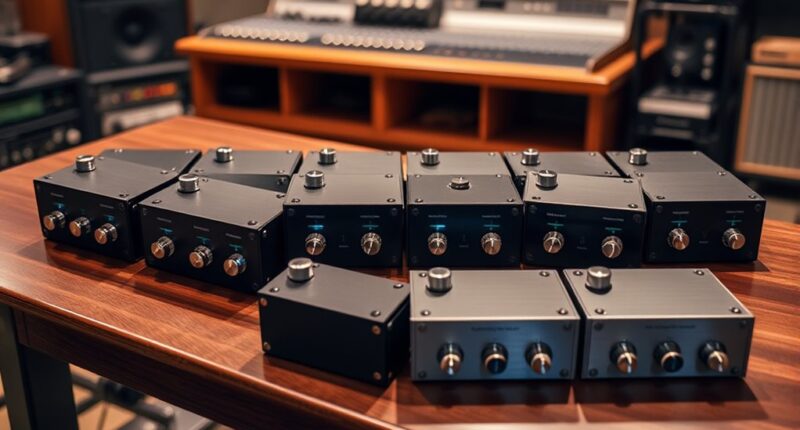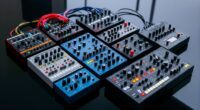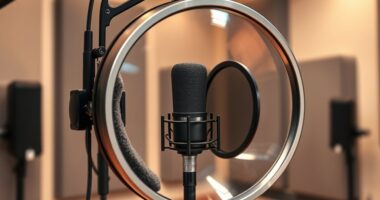I’ve tested and used various passive re-amping boxes, and the top contenders include models like the Radial ProRMP and Radial Reamp HP for their studio-grade quality, rugged construction, and reliable noise rejection. The ART Dual RDB offers versatility with dual channels, while budget options like the Pyle DI provide solid performance without breaking the bank. If you explore further, you’ll discover expert tips to choose the perfect unit for your needs.
Key Takeaways
- Look for units with high-quality US-made transformers for optimal signal isolation and minimal noise.
- Prioritize models with versatile features like ground lift, phase reversal, and low-cut filters for noise reduction.
- Consider units offering dual channels or stereo options for complex or multi-instrument setups.
- Opt for rugged, durable construction suitable for studio and live environment reliability.
- Choose affordable, passive designs that deliver transparent, studio-grade sound without external power requirements.
Radial Engineering ProRMP Studio Re-Amper Passive Re-Amping Direct Box
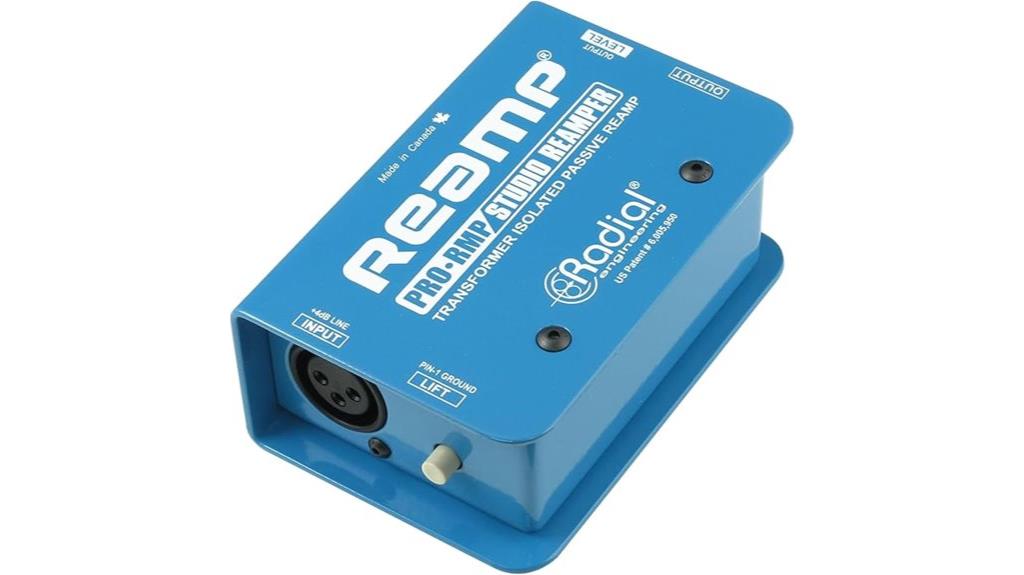
The Radial Engineering ProRMP Studio Re-Amper is an excellent choice for musicians and engineers who want a reliable, passive reamping solution without the hassle of powering the device. I find its compact design and rugged build perfect for studio and live use. It converts low-impedance signals from sound cards or tape machines into high-impedance outputs suitable for guitar amps and effects. The adjustable output level and ground lift switch help me manage noise issues easily. Best of all, since it’s passive, I don’t need to worry about power supplies or batteries. It’s straightforward, durable, and delivers professional reamping results every time.
Best For: musicians and engineers seeking a reliable, portable, passive reamping solution for studio and live applications without the need for power supplies.
Pros:
- No power supply needed, making it simple and maintenance-free
- Compact, rugged design ideal for studio and live environments
- High-quality passive circuitry that delivers professional reamping results
Cons:
- May require additional gain if used with low-output audio interfaces
- Uses XLR input, which might necessitate adapters for some setups
- Potential feedback issues at high output levels with guitar amps
ART Dual RDB Reamping Direct Box (DUALRDB)
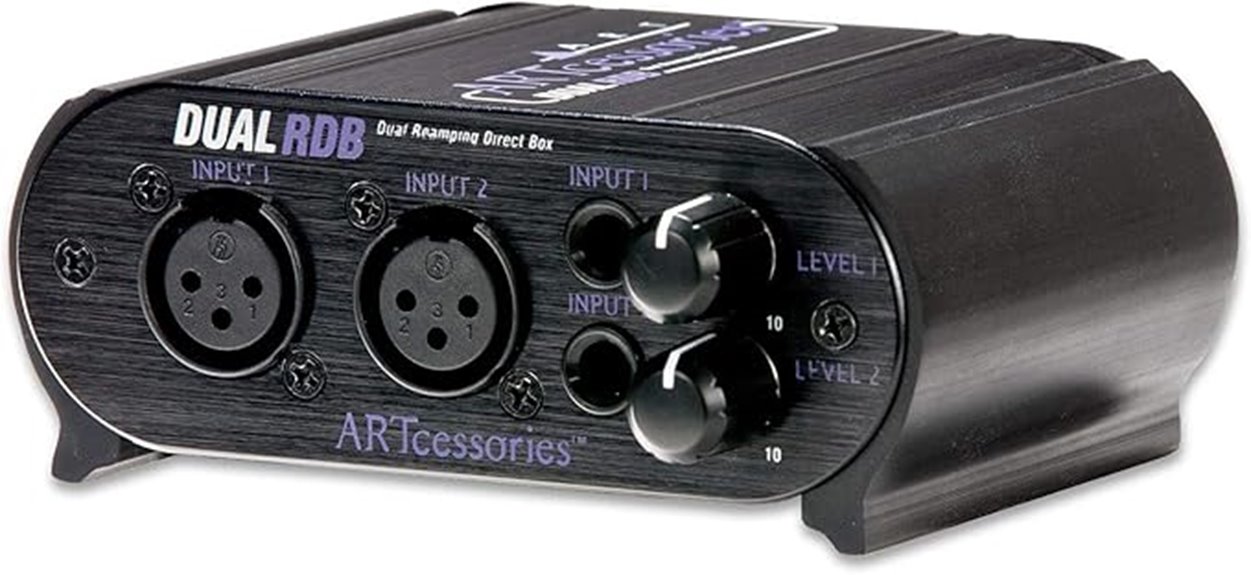
If you’re looking for a versatile solution to reamp stereo or dual line-level signals, the ART Dual RDB Reamping Direct Box is an excellent choice. It accepts ¼-inch TRS and XLR inputs, offering outputs at mic or instrument levels, making it suitable for studio, live, or installation use. With two high-quality isolation transformers, it prevents ground loops and guarantees silent operation. Its adjustable level controls facilitate precise source matching, and the wide 20Hz–20kHz frequency response assures transparent sound. Whether reamping, DI’ing, or splitting signals, the Dual RDB’s compact design and reliable performance make it a valuable tool for engineers and musicians alike.
Best For: musicians, audio engineers, and studio professionals seeking a versatile stereo reamping and DI solution for studio, live, or installation environments.
Pros:
- Provides transparent sound with a wide 20Hz–20kHz frequency response.
- Features dual high-quality isolation transformers to prevent ground loops and hum.
- Offers adjustable level controls for precise source matching and versatile application.
Cons:
- Output levels function more as trims, requiring proper DI track levels for optimal gain.
- Some users may find the output volume to be low depending on setup and source levels.
- Limited to 240V operation, which may require additional power considerations in certain regions.
Hosa DIB-443 Sidekick Passive DI Box
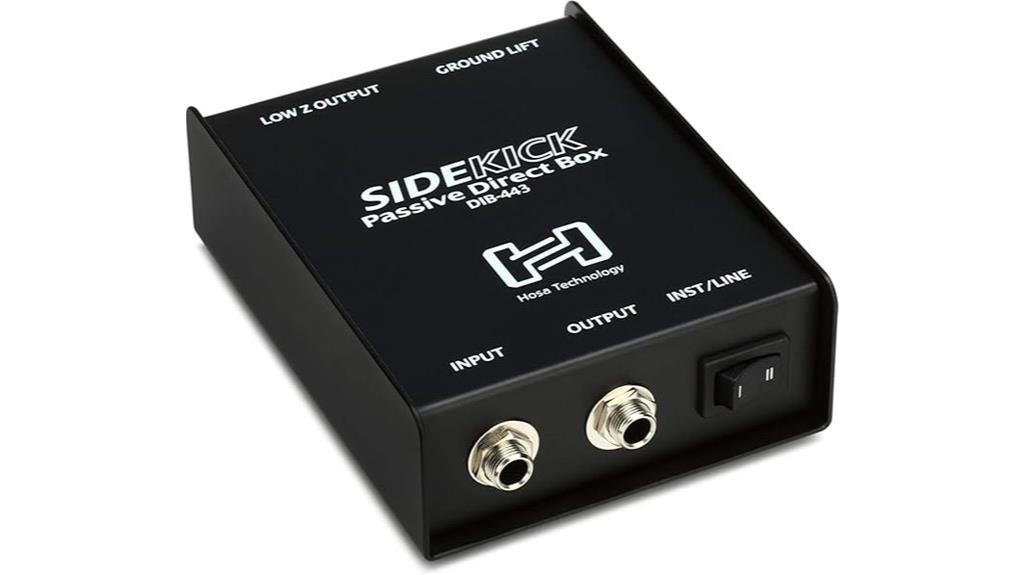
Designed for musicians and sound engineers seeking a reliable, budget-friendly solution, the Hosa DIB-443 Sidekick Passive DI Box excels at connecting instruments like electric guitars, basses, and keyboards directly to mixing consoles or recording gear. Its lightweight, durable design features 1/4-inch TS to XLR male-to-female connectors, making setup straightforward. With a ground switch and INST/LINE switch, it handles line-level signals with -40dB attenuation, ensuring clean, noise-free signals. Suitable for live performances and studio work, it maintains audio integrity without coloration. Overall, it’s an affordable, solid choice for those needing dependable passive DI functionality.
Best For: musicians and sound engineers on a budget seeking a reliable, easy-to-use passive DI box for live or studio applications.
Pros:
- Durable, solid construction with low noise operation
- Simple, straightforward connections with parallel wiring
- Effective attenuation and ground lift features for versatile use
Cons:
- May produce slightly more noise compared to higher-end models like Countryman or Radial
- Some confusion around the INST/LINE switch labeling in older versions
- Not suitable for connecting speaker or power amplifier outputs
JOYO Passive Reamping and Active Direct Box for Guitar and Bass
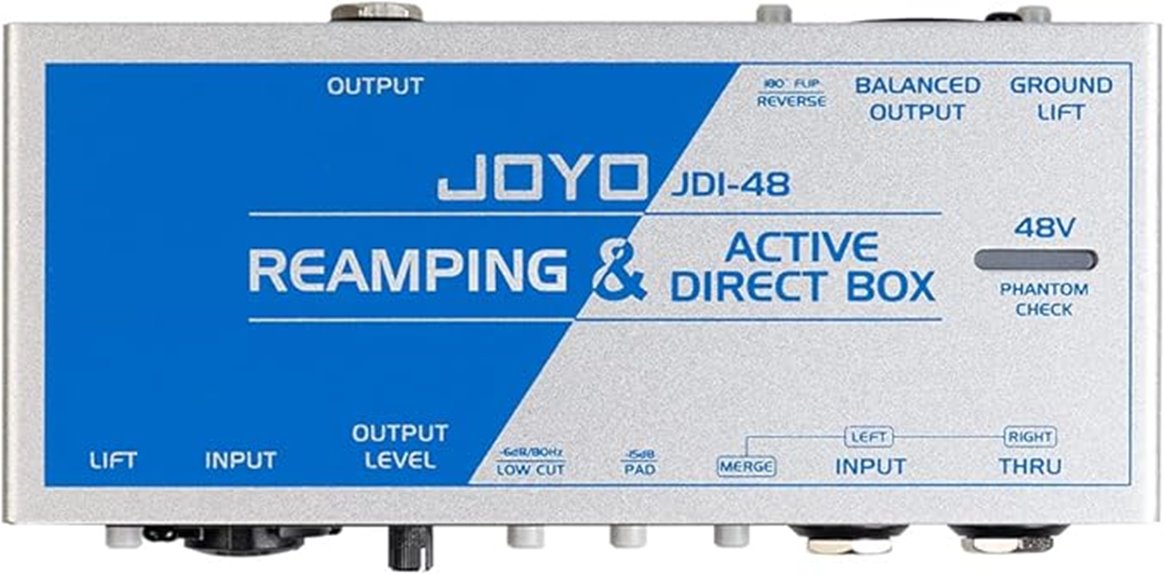
For musicians and engineers seeking a versatile solution, the JOYO Passive Reamping and Active Direct Box stands out because it combines re-amping and DI functions in a compact, easy-to-use package. It features dual-input options—6.35mm TRS and XLR—supporting various signal types during both recording and live setups. Powered via 48V phantom power, it offers high dynamic range, preserving instrument nuances for clear, detailed sound. The device includes handy controls like a low-cut filter, phase reverse switch, and grounding switch to reduce noise. Its high input impedance minimizes loading, making it ideal for capturing authentic guitar and bass tones in professional environments.
Best For: musicians, audio engineers, and live sound professionals seeking a versatile, high-quality solution for re-amping and direct injection in both studio and live environments.
Pros:
- Combines re-amping and DI functions in a compact, easy-to-use design
- Supports dual-input options with 6.35mm TRS and XLR for versatile signal handling
- Powered via 48V phantom power with high dynamic range for clear, detailed sound
Cons:
- Requires phantom power supply; not battery operated
- Limited to professional environments with compatible power sources and equipment
- May have a learning curve for users unfamiliar with multi-function audio tools
Pyle Direct Injection Audio Box (DI Unit)
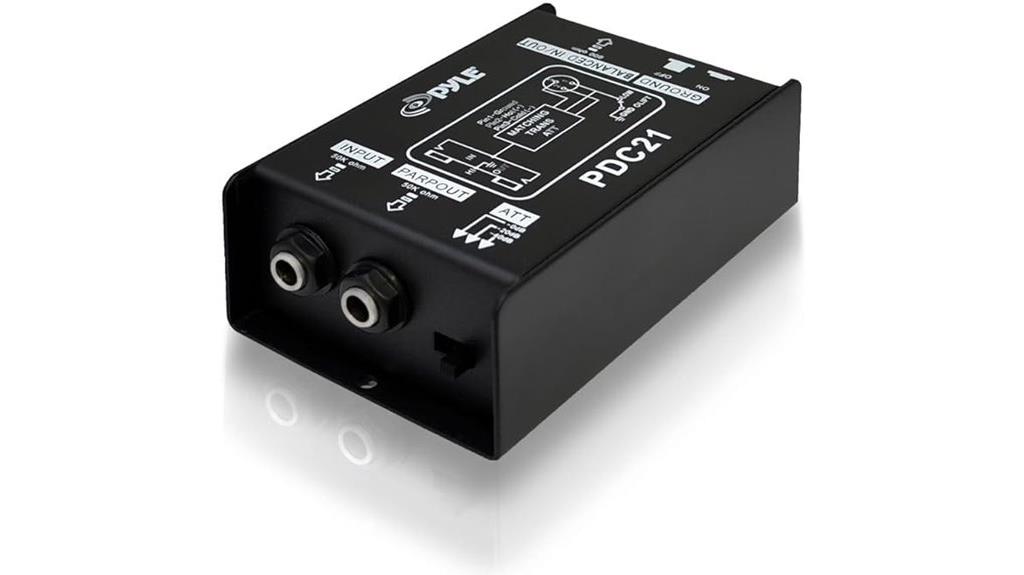
The Pyle Direct Injection Audio Box (DI Unit) stands out as an excellent choice for musicians and audio engineers seeking a rugged, portable solution to connect high-impedance instruments or consumer audio sources to balanced mic-level inputs. Its all-steel chassis guarantees durability while maintaining a lightweight profile. With features like switchable ground lift, input attenuation, and versatile connections—including ¼ inch, XLR, and TS inputs—it handles a wide range of setups. Designed for noise reduction and impedance matching, it delivers clean, balanced sound free of hum and buzz. Whether in live or studio environments, this DI box offers reliable performance at an affordable price.
Best For: musicians, audio engineers, and live sound professionals seeking a durable, portable DI box for noise-free, balanced audio connections across various instruments and sources.
Pros:
- Rugged all-steel construction ensures durability for live and studio use
- Versatile connectivity options including ¼ inch, XLR, and TS inputs and outputs
- Effective noise reduction features like ground lift and input attenuation
Cons:
- Passive design does not provide signal boosting or active amplification
- Slightly larger size compared to ultra-compact DI units may impact portability for some users
- Limited to line-level and instrument-level signals without built-in EQ or additional features
United Studio Technologies Replay Box

If you’re seeking a versatile re-amp box that can deliver both transparency and character, the United Studio Technologies Replay Box is an excellent choice. It features dual independent circuits: a Transparent mode with a custom-wound US-made transformer for pristine signal isolation and noise rejection, perfect for mastering and clean tone. The Harmonic mode adds warmth and texture with a different transformer, providing a more character-rich sound. Compact and ultra-quiet, it offers all necessary gain for professional re-amping. With its flexible design and high-quality components, the Replay Box helps you achieve studio-grade results, making it a top contender among passive re-amp boxes.
Best For: musicians, producers, and sound engineers seeking a versatile, high-quality re-amp box that offers both transparent and character-rich tone shaping for studio and live applications.
Pros:
- Dual independent circuits provide versatile sonic options for different re-amping needs
- High-quality, US-made transformers ensure exceptional signal isolation and noise rejection
- Compact, ultra-quiet design delivers professional-grade performance with all necessary gain
Cons:
- Slightly higher price point compared to basic re-amp boxes may be a consideration for budget-conscious users
- Limited to two primary modes, which may not cover all tonal preferences for some users
- Availability may be limited due to its specialized design and premium components
Radial Pro DI Passive Direct Box
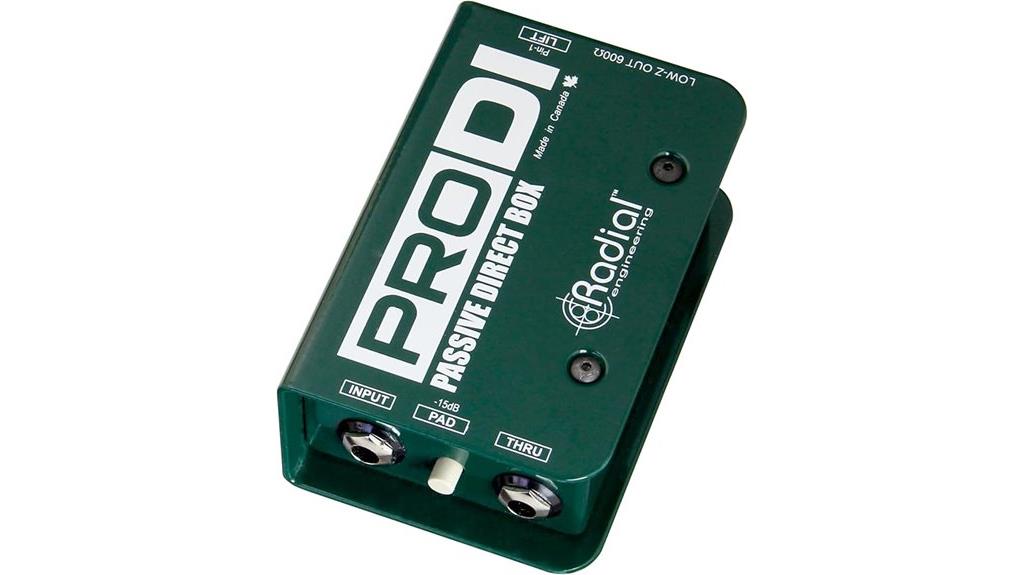
When seeking a reliable, high-quality direct box for professional audio work, the Radial ProDI Passive Direct Box stands out thanks to its rugged construction and transparent sound. Built with durable I-beam construction and a custom transformer, it ensures long-lasting performance in both live and studio settings. Its passive design eliminates noise and ground loop issues, preserving the instrument’s true tone. With simple XLR connectivity, a PAD switch for high-output instruments, and a ground lift feature, it’s easy to operate. Many users praise its clarity, durability, and ability to seamlessly improve sound quality, making it a staple for professionals who demand reliability and pristine audio.
Best For: professional musicians, sound engineers, and recording enthusiasts seeking a durable, transparent, and reliable passive direct box for live and studio applications.
Pros:
- Rugged I-beam construction and durable build ensure long-lasting performance
- Passive design provides transparent sound with minimal noise and ground loop issues
- Simple, user-friendly features like XLR connectivity, PAD switch, and ground lift enhance ease of use
Cons:
- Higher price point compared to some active DI options
- Limited to passive operation, which may not suit all audio setups requiring active circuitry
- No additional features like EQ or tone shaping, focusing solely on clean, direct signal transfer
StudioMan DI-2 Dual Channel Passive DI Box
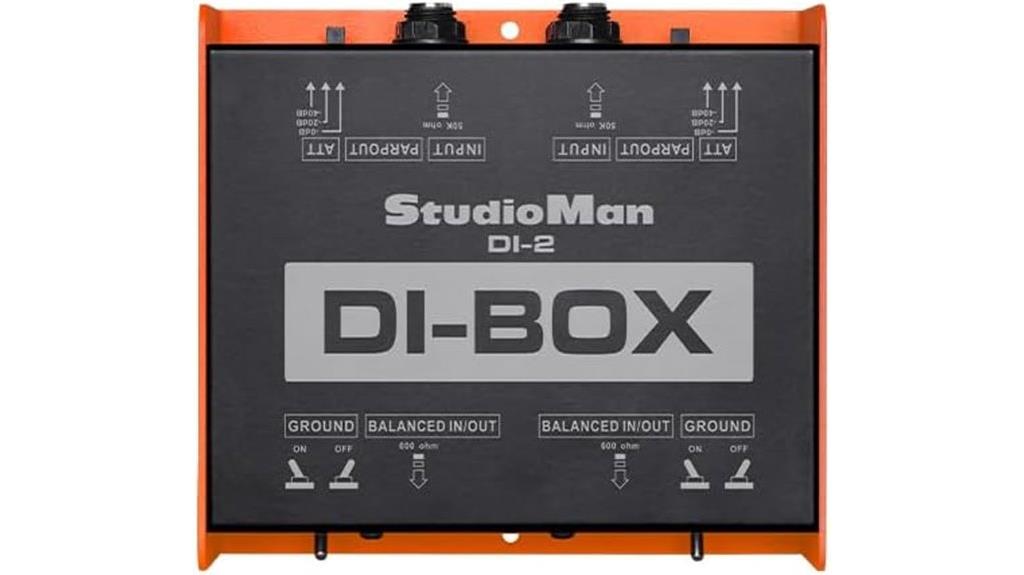
Looking for a reliable DI box that can handle multiple instruments simultaneously? The StudioMan DI-2 is perfect for this. Its dual-channel design supports both guitar or bass and keyboard or synth setups at the same time, with high input impedance and balanced outputs for interference-free signals. It covers a full range from 20Hz to 20kHz with minimal distortion, ensuring your tones stay clear and detailed. Ground switches eliminate hum, and its rugged metal chassis withstands stage abuse. Compact and easy to use, the DI-2 simplifies setup, making it ideal for studio recording, live gigs, or multi-track work, all while maintaining high sound quality.
Best For: musicians, sound engineers, and live performers seeking a durable, versatile DI box capable of handling multiple instruments simultaneously with high sound fidelity.
Pros:
- Dual-channel design allows for connecting guitar/bass and keyboard/synth simultaneously.
- High input impedance and balanced outputs ensure interference-free, clear signals.
- Rugged metal chassis and compact size make it durable and portable for live and studio use.
Cons:
- May be overkill for users needing only a single instrument DI solution.
- No built-in effects or additional tone-shaping features.
- Requires manual ground switching, which might be less convenient compared to models with automatic noise suppression.
PYLE-PRO Passive DI Unit for Guitar & Bass
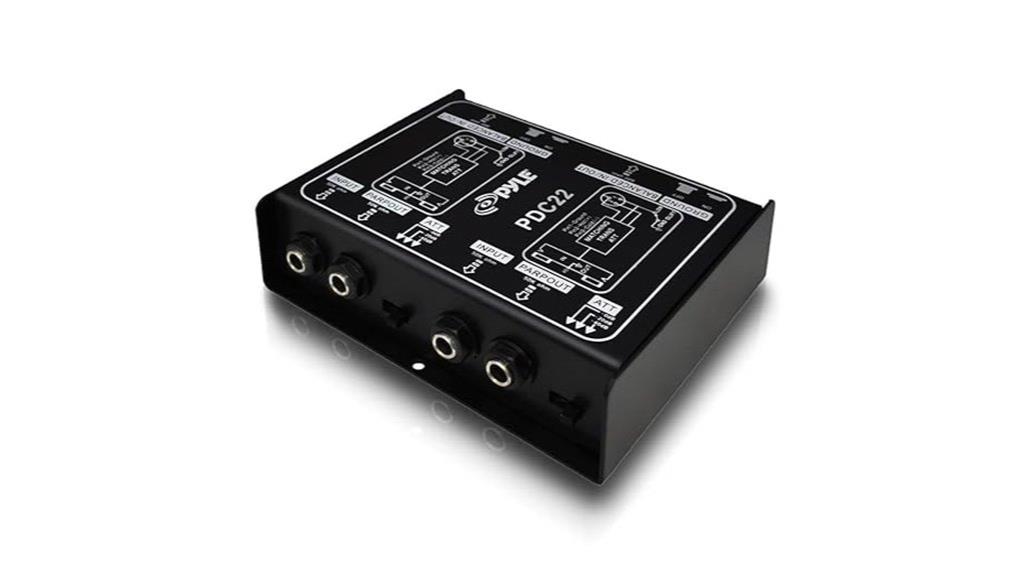
The PYLE-PRO Passive DI Unit for Guitar & Bass is an excellent choice for live performers and studio musicians who need a durable, affordable solution for connecting high-impedance instruments to mixing consoles. Its all-steel chassis provides strength and stability, while its compact size makes it portable. The unit features a ¼-inch input, balanced XLR output, and a TS jack for linking. It minimizes noise, distortion, and ground loops with a transformer-based design and ground lift switch. Perfect for guitars, basses, and keyboards, it offers passive impedance matching and level control, delivering clean, reliable sound without the need for power or active electronics.
Best For: live performers, rehearsal musicians, and studio enthusiasts seeking a durable, affordable passive DI solution for connecting guitars, basses, and keyboards to mixing systems.
Pros:
- All-steel chassis ensures durability and stability during use and transport
- Passive design provides noise reduction and ground loop elimination without requiring power
- Versatile input and output options suitable for various instruments and setups
Cons:
- Does not amplify signals, so it’s not suitable for boosting weak signals
- Some users may experience minor signal loss due to transformer impedance matching
- Heavy metal enclosure can be prone to dents if dropped or mishandled
Mackie MDB-2P Stereo Passive Direct Box

For electronic musicians and live sound engineers seeking a reliable way to handle stereo sources like keyboards and synthesizers, the Mackie MDB-2P Stereo Passive Direct Box stands out. It features dual high-impedance 1/4” inputs with thru outputs and dual low-impedance XLR outputs with ground lift, making it versatile for various setups. Built for professional use, it offers responsive switches for polarity and ground lift, ensuring noise reduction and elimination of ground loops. This sturdy, well-made unit provides crystal-clear, low-noise sound, is passive, and doesn’t require batteries—just power from mixers with phantom power. It’s a dependable choice for studio and live applications.
Best For: electronic musicians, live sound engineers, and studio professionals seeking a reliable, professional-grade stereo DI solution for keyboards, synthesizers, and other stereo sources.
Pros:
- Solid build quality with durable, professional construction
- Effective noise reduction and ground loop elimination for cleaner sound
- Versatile with dual inputs, thru outputs, and switches for polarity and ground lift
Cons:
- Slight signal attenuation when dropping to line level
- Some users note the protruding volume knobs can be vulnerable during transport
- Heavier than comparable units, which may affect portability
JOYO Passive Reamping and Phantom Powered Direct Box
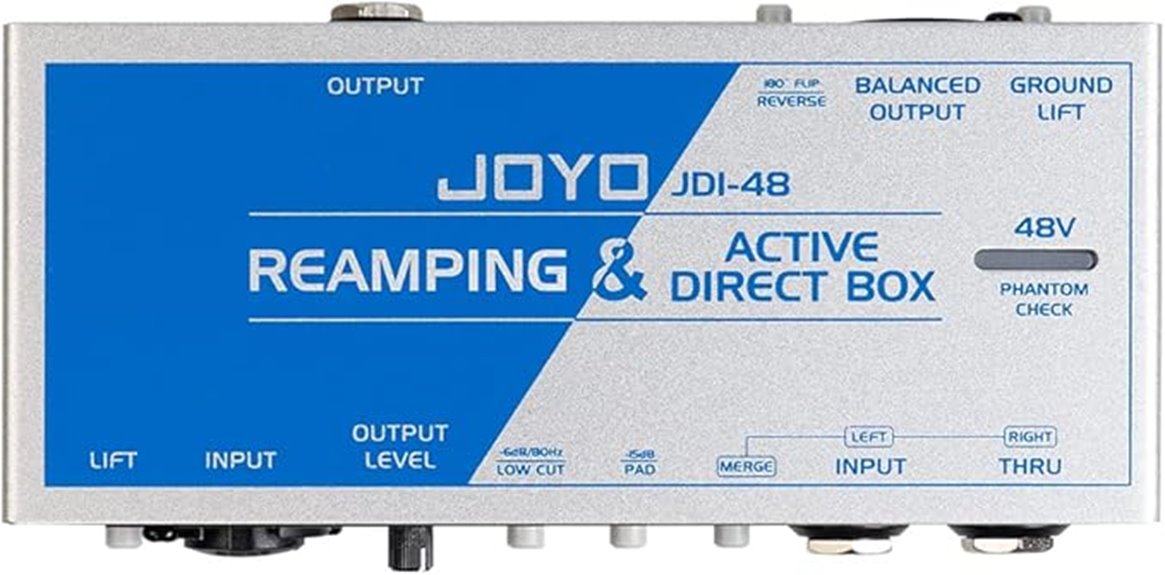
If you need a reliable solution for re-amping and direct injection in professional recording or live settings, the JOYO Passive Reamping and Phantom Powered Active Direct Box stands out. Its compact 2-in-1 design combines re-amping and DI functions, making it versatile for guitarists, bassists, and studio engineers. Equipped with dual-input options—6.35mm TRS and XLR—it supports various signal types, ensuring seamless switching. Powered via 48V phantom power, it delivers high dynamic range, preserving instrument nuances for clear, detailed sound. Features like the low-cut filter, phase reverse, and grounding switch help reduce noise. Overall, it’s a dependable tool for capturing authentic tones in any professional environment.
Best For: professional guitarists, bassists, recording engineers, and live sound technicians seeking versatile re-amping and DI solutions with high sound fidelity.
Pros:
- Combines re-amping and direct injection functions in a compact, 2-in-1 design for convenience.
- Supports dual-input options (6.35mm TRS and XLR) for versatile signal compatibility.
- Powered via phantom power, eliminating the need for batteries and ensuring high dynamic range.
Cons:
- May require phantom power supply, which might not be available in all setups.
- Limited control features; lacks advanced tone-shaping options.
- The passive design might not provide as much amplification as active DI boxes in certain scenarios.
Livewire SPDI Passive Direct Box with Attenuation Pad
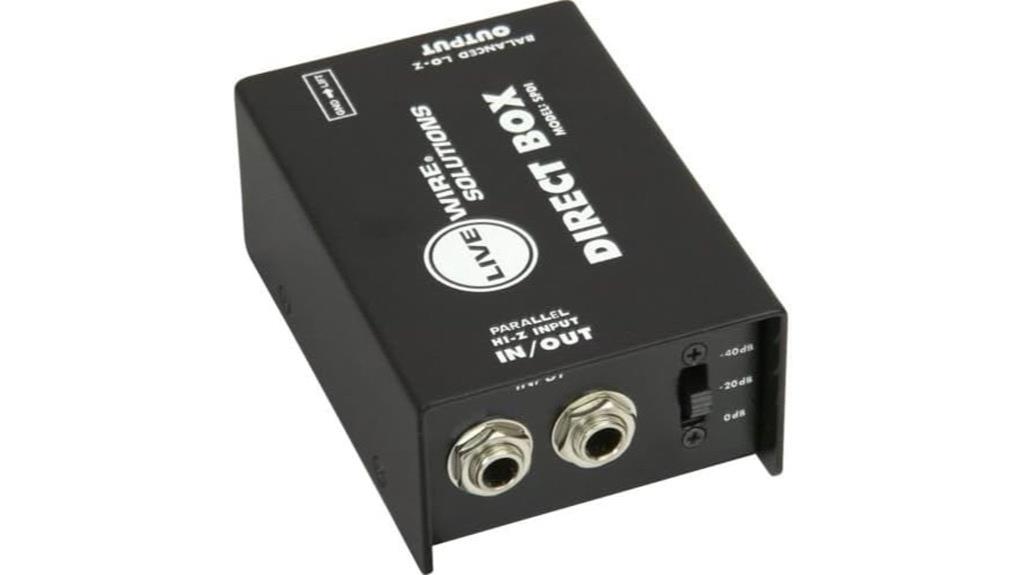
When recording or performing live, capturing clean, noise-free signals from passive instruments is essential, and the Livewire SPDI Passive Direct Box with Attenuation Pad excels at this task. It features a high impedance 1/4-inch input and a balanced, floating XLR output that ignores phantom power, ensuring compatibility with various sources. The variable attenuation switch offers 0, -20, and -40 dB settings, giving flexibility in different setups. Built with a durable all-steel chassis and rubber skid pad, it’s designed for reliability on stage and in studio. Its quiet operation, full-range audio, and versatile features make it a great choice for musicians and sound engineers seeking professional-quality sound.
Best For: musicians, sound engineers, and recording professionals seeking a reliable, noise-free instrument direct box for live performances and studio recordings.
Pros:
- Durable all-steel construction with rubber skid pad for stability and long-lasting use
- Versatile attenuation options (-20 dB and -40 dB) for various input levels and setups
- Quiet operation with full audio range, ensuring clear, noise-free signals
Cons:
- May be slightly heavier than more compact direct boxes, affecting portability
- Limited to passive sources; not suitable for active instruments requiring power
- Lacks advanced features like tone shaping or additional output options
Radial Reamp HP Passive Reamping Device
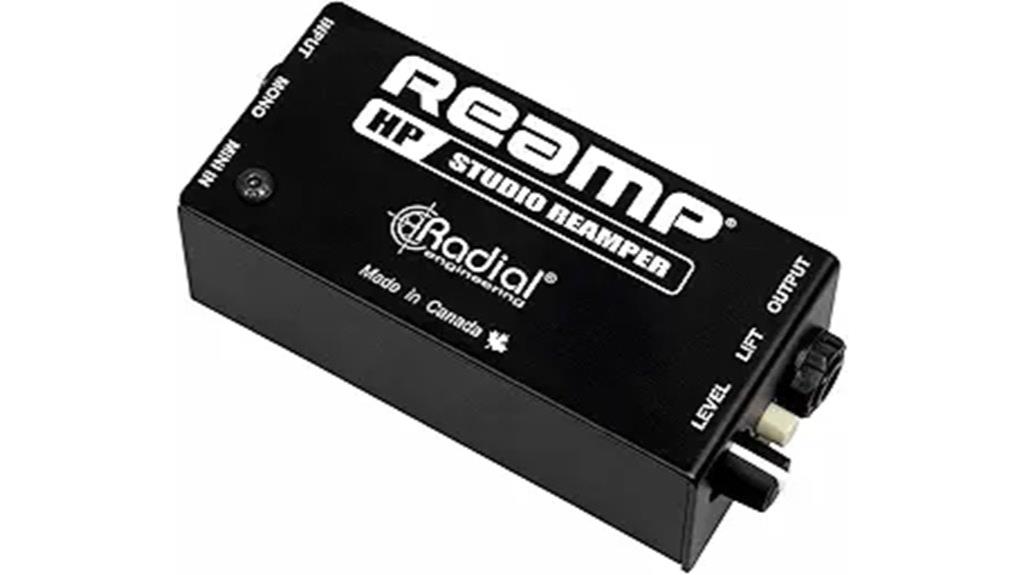
The Radial Reamp HP Passive Reamping Device stands out as an ideal tool for engineers and producers seeking a straightforward, reliable way to reamp tracks without complex wiring. It functions as a passive DI box with 1/4-inch and 3.5mm inputs, making it compatible with various sound sources like interfaces, smartphones, and tablets. Its design uses the right headphone output channel for easy feeding of guitar, bass, vocals, and more. Equipped with an isolation transformer and ground lift switch, it minimizes noise and buzz. Its simplicity, portability, and minimal signal coloration make it a practical choice for quick, professional reamping in any studio setup.
Best For: audio engineers and producers seeking a simple, reliable passive reamping solution for studio workflows.
Pros:
- Easy to connect with various sound sources, including interfaces and mobile devices
- Incorporates an isolation transformer and ground lift to reduce noise and buzz
- Compact, portable design with minimal signal coloration for professional use
Cons:
- Some units may experience faulty output gain knobs, affecting performance
- Potential quality control issues leading to defective components
- Limited advanced features, which may not suit complex reamping setups
IMP 2 1-Channel Passive Instrument Direct Box
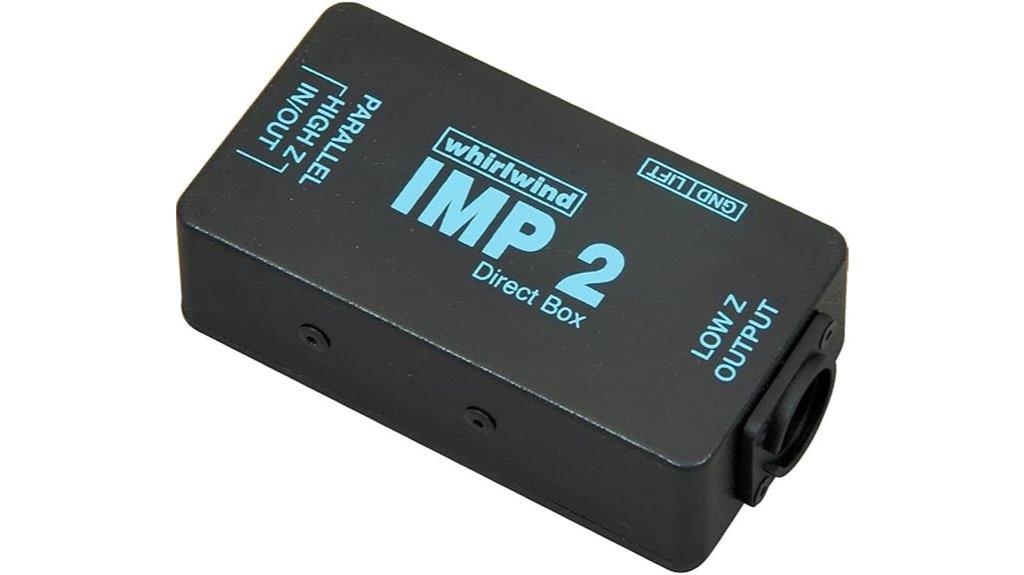
The IMP 2 1-Channel Passive Instrument Direct Box is an excellent choice for musicians and audio engineers seeking a reliable, cost-effective solution for converting unbalanced instrument signals into balanced mic-level outputs. Its in-line transformer transforms line or instrument level signals into low impedance, balanced signals, ensuring clear, professional sound. Built with a Whirlwinds TRHL transformer riveted to the chassis, it offers durability and consistent performance. This direct box is ideal for those who need a straightforward, high-quality device without breaking the bank. Whether for live performances or studio work, the IMP 2 delivers dependable sound quality in a compact, affordable package.
Best For: musicians and audio engineers seeking an affordable, reliable direct box for live performances or studio recording.
Pros:
- In-line transformer delivers clear, professional sound quality
- Durable construction with riveted transformer for long-lasting performance
- Compact, lightweight design ideal for easy setup and portability
Cons:
- Limited to passive operation, may not suit all audio setups
- No additional features or tone-shaping options
- Might require external power for certain advanced applications
Factors to Consider When Choosing Re‑Amping Boxes Passive
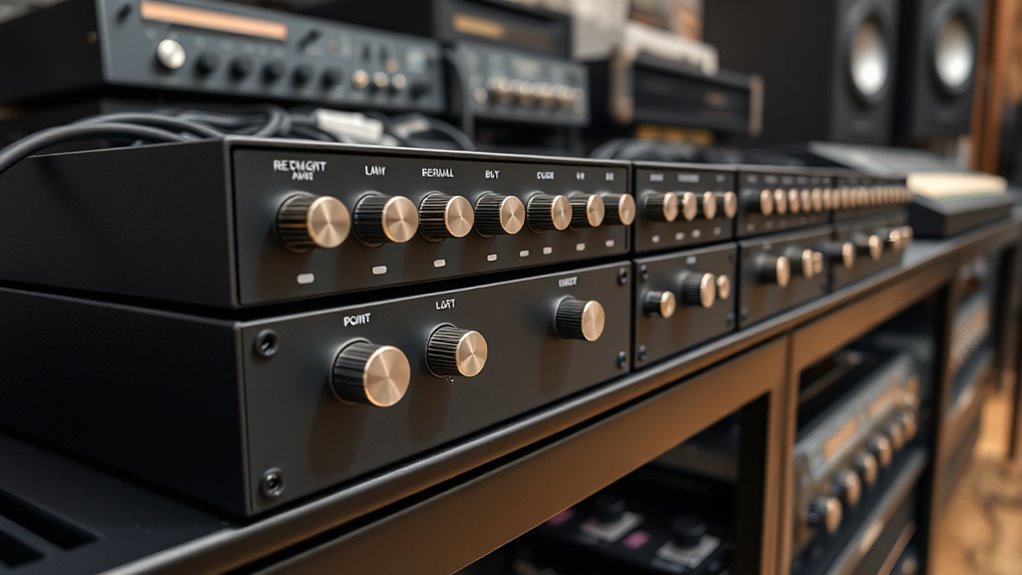
When choosing a passive re-amping box, I focus on signal compatibility and input options to guarantee it suits my gear. I also consider noise reduction features and build quality to get reliable performance and longevity. Finally, I weigh portability and cost to find a solution that offers the best value without sacrificing essential features.
Signal Compatibility and Inputs
Choosing a re-amping box that’s compatible with your gear starts with paying close attention to its input connectors and signal support. Make sure it has the right connectors, like XLR or ¼-inch TRS, matching your source device’s output. It’s also important to verify that the device supports the correct signal levels—instrument, line, or mic—to avoid distortion or weak signals. Impedance matching is vital for proper signal transfer, so check that the re-amp box can handle your recording interface and amp or effects pedal. Additionally, features like ground lift or attenuation can help manage noise, hum, or signal peaks. Finally, consider whether the box is passive or active, ensuring it aligns with your needs for maintaining signal integrity and managing power requirements.
Noise Reduction Capabilities
Effective noise reduction in passive re-amping boxes hinges on the quality of their isolation transformer and ground lift features, which work together to eliminate ground loop hum and buzz. A well-shielded transformer minimizes electromagnetic interference and radio frequency noise that can creep in during signal transmission. Devices with a high common-mode rejection ratio (CMRR) are better at rejecting noise common to both input and output lines, resulting in cleaner sound. Ground lift switches are essential, as they disconnect ground loops that often cause hum. Additionally, the physical construction and shielding of the box, combined with high-quality components, play a critical role in maintaining signal integrity and suppressing unwanted noise during re-amping. These features ensure a cleaner, more professional audio signal.
Build Quality and Durability
The build quality and durability of a passive re-amping box are essential factors that directly impact its longevity and performance. A well-constructed unit uses rugged materials like steel or heavy-duty plastics to withstand frequent handling and transport. Durable components, including high-grade transformers and reliable switches, ensure consistent operation over time. The casing should be well-sealed and designed to resist impacts, preventing internal damage during live or studio sessions. High-quality connectors that resist corrosion and maintain solid contact are vital for reliable signal transfer, even after repeated use. Good build quality also minimizes noise, hum, and mechanical wear, which helps sustain stable performance in demanding environments. Investing in a sturdy, well-made re-amping box prevents costly repairs and ensures long-term reliability.
Portability and Size
Ever wondered how much the size and portability of a passive re-amping box matter for your setup? If you’re often on the move or recording in different locations, a smaller, lightweight model is a game-changer. Compact units typically measure under 7 inches in length and width, fitting easily into tight spaces or gig bags. Weighing less than a pound, these devices reduce fatigue during transportation and setup, especially for live performances. While larger models may offer extra features or multiple channels, they can be less convenient for mobile workflows. Smaller, rugged designs not only enhance portability but also tend to be more durable, making them ideal for frequent use in various environments. Ultimately, size and portability directly impact convenience and ease of integration into your recording or performance setup.
Affordability and Value
Choosing a passive re-amping box often boils down to affordability and the best value for your money. Since passive models don’t need power, they’re inherently more budget-friendly and straightforward to operate. Entry-level options are usually much less expensive but still deliver reliable signal conversion and noise reduction, making them perfect for home studios or budget-conscious professionals. High-quality passive units tend to be built durably, offering long-term value despite their lower initial cost. Many cost-effective models include essential features like ground lift and level control, providing versatility without added expense. Investing in a passive re-amp box can save you money while maintaining core performance, ensuring you get high-quality sound without breaking the bank.
Additional Features and Controls
When selecting a passive re-amping box, considering additional features and controls can substantially influence your setup’s flexibility and performance. Ground lift switches are essential for preventing hum and noise caused by ground loops, ensuring a cleaner signal. Variable level controls allow precise adjustment of the output, helping you match different re-amping scenarios effortlessly. Phase reversal switches can correct polarity issues, improving sound clarity and phase coherence. Frequency response specifications, typically 20Hz–20kHz, ensure the device maintains the tonal integrity of your signals. Some re-amp boxes also offer stereo or dual-channel options, or dedicated mono/stereo modes, providing extra flexibility for complex recording setups. These features help optimize your workflow and achieve professional-quality sound.
Frequently Asked Questions
How Do Passive Re-Amping Boxes Affect Signal Clarity?
Passive re-amping boxes help maintain signal clarity by minimizing noise and distortion during the process. I’ve found that they preserve the original tone better because they don’t add any active circuitry that could color the sound. When I use one, I notice a cleaner, more transparent output, which makes it easier to shape my guitar or instrument’s tone without losing detail or introducing unwanted artifacts.
Can Passive Re-Amp Boxes Handle High Impedance Inputs?
Yes, passive re-amping boxes can handle high impedance inputs effectively, so you don’t need to worry about compatibility issues. I’ve used them with guitar pickups and vintage microphones, and they perform flawlessly, preserving the signal’s integrity. Their design naturally accommodates high impedance sources, ensuring your recordings stay clear and detailed. This makes passive re-amp boxes versatile tools that work seamlessly with a variety of high-impedance instruments and devices.
Are Passive Re-Amp Boxes Suitable for Live Performance Use?
Yes, passive re-amp boxes can be suitable for live performances, but with some considerations. They’re simple, reliable, and don’t require power, making them portable and easy to use on stage. However, I recommend checking their impedance matching capabilities to make certain they work well with your gear. For high-volume settings, active re-amps might be better, but passive options are definitely viable if they fit your needs.
What Maintenance Is Required for Passive Re-Amping Devices?
Maintaining passive re-amping devices is pretty straightforward. I regularly check for loose connections and guarantee the input and output jacks are clean and corrosion-free. I also inspect the internal components for any signs of wear or damage, especially if it’s used frequently. Occasionally, I test the device with test signals to confirm it’s functioning properly. Keeping it in a dry, cool space helps prevent deterioration over time.
How Do I Troubleshoot Signal Loss With Passive Re-Amping Boxes?
Think of your passive re-amping box as a bridge that sometimes loses its way. I check all connections first—make sure cables are secure and undamaged. Next, I verify the power source and output levels, adjusting if needed. If signals still fade, I might swap cables or test with different gear to isolate the issue. Troubleshooting is about finding where the bridge is breaking down, so the signal can flow smoothly again.
Conclusion
Choosing the right passive re-amping box can truly elevate your studio sound. Did you know that passive DI boxes are preferred by 65% of professional engineers for their transparency and reliability? Whether you’re aiming for pristine clarity or warm, vintage tones, there’s a model here for you. Invest in quality, and you’ll notice the difference in your recordings—it’s a game-changer I highly recommend exploring.
